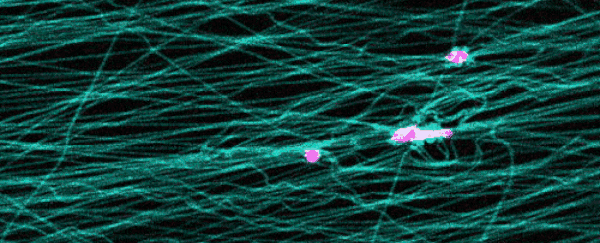Even though our bodies feel solid, the cells within don't always sit still in one spot. Scientists have now spotted cells 'slingshotting' themselves around, using tension in fibrous tissue to jump forward up to five times faster than we've ever seen before.
While researchers think this "slingshot migration" may play a role in the spread of cancer through the body, it might also be harnessed to help us send healthy cells to the parts of the body that need them the most.
To catch the speedy cells in transit, scientists set up artificial 3D scaffolds that modelled stromal tissue, the type of connective tissue surrounding organs in the human body. This tissue can either help or hinder the spread of diseases like cancer.
"I was definitely shocked seeing a cell move so fast," says one of the researchers, biomedical engineer William Wang from the University of Michigan.
"What was even more surprising was then capturing this migration mode in multiple cell types and finding that their speed was so much faster than traditional modes of cell migration."
What makes this study stand out is the use of that 3D scaffold rather than a 2D petri dish, getting the researchers closer to the conditions that exist inside the actual body.
The observed slingshotting works very much like the term would suggest, with cells pulling on surrounding tissue to create tension, then shooting forward when the tension gets released.
"We found that cells can move in this very distinct way that results in effective migration far faster than anything previously reported," says one of the team, Brendon Baker from the University of Michigan.
There are various different types of cell migration, but we haven't seen this one before. As imaging techniques improve, we're starting to get a better understanding of how cells are able to make their way through the body, and more discoveries like this might be on the way.
 The 'slingshot' movement of cells (in pink) under the microscope. (University of Michigan)
The 'slingshot' movement of cells (in pink) under the microscope. (University of Michigan)
In this case the bouncy mode of travel was found to apply to mesenchymal cells in fibres that provided just the right balance of softness and strength – tissue that was resistant enough to build up tension but not too resistant to prevent stretching in the first place.
It's a cool effect when observed under a microscope, but there are sinister undertones. The researchers suggest this mechanism might contribute to cancer metastasis, when cancer cells move from the primary tumour to other parts of the body, a process that can directly involve stromal tissue.
Understand more details about the spread of cancer is crucial if we are to devise ways to stop it. And further down the line the technique could be harnessed to provide rapid relief to other types of diseases and injuries too.
"Given the prevalence of fibrous tissues, an understanding of how matrix structure and mechanics influences migration could improve strategies to recruit repair cells to wound sites or inhibit cancer metastasis," conclude the researchers.
The research has been published in Nature Communications.
